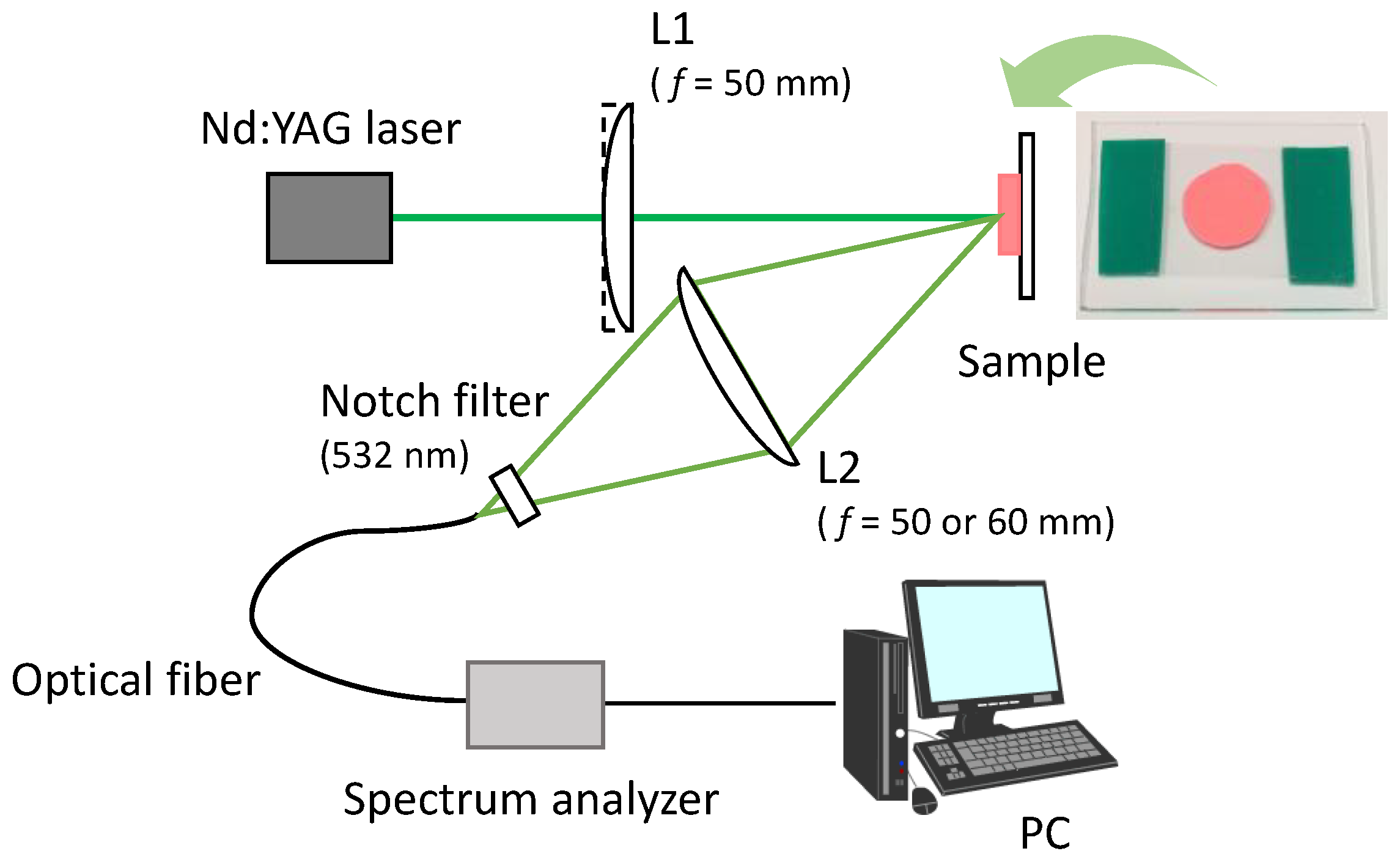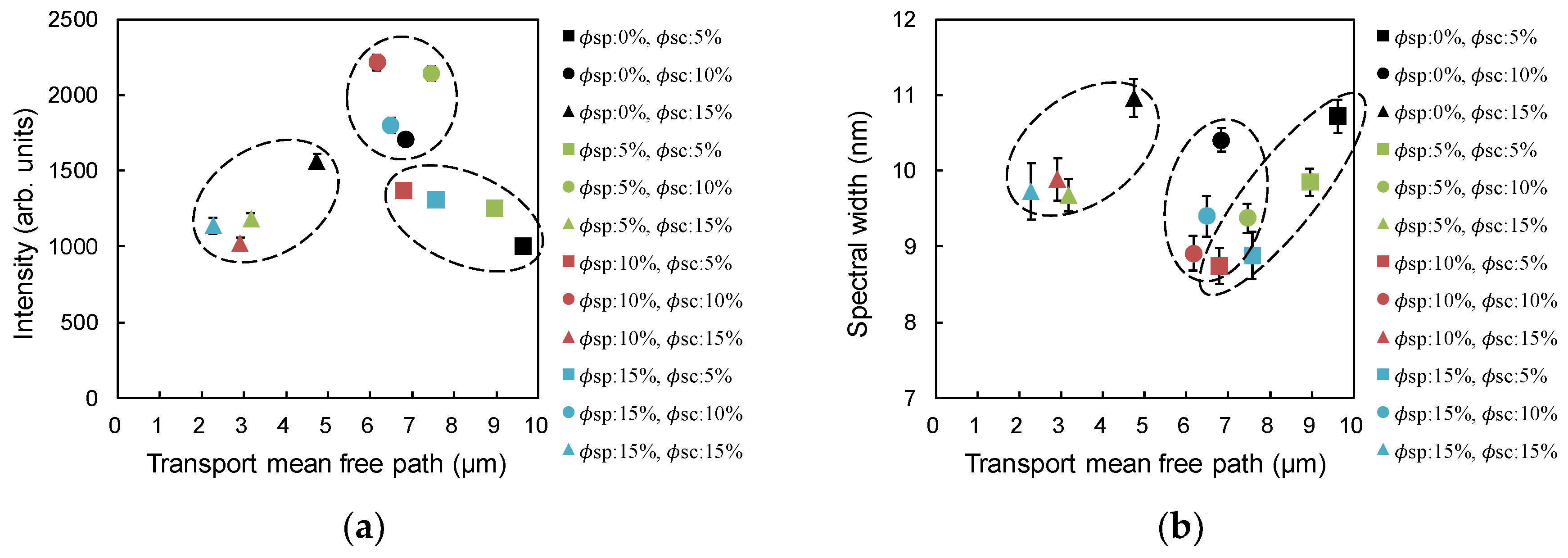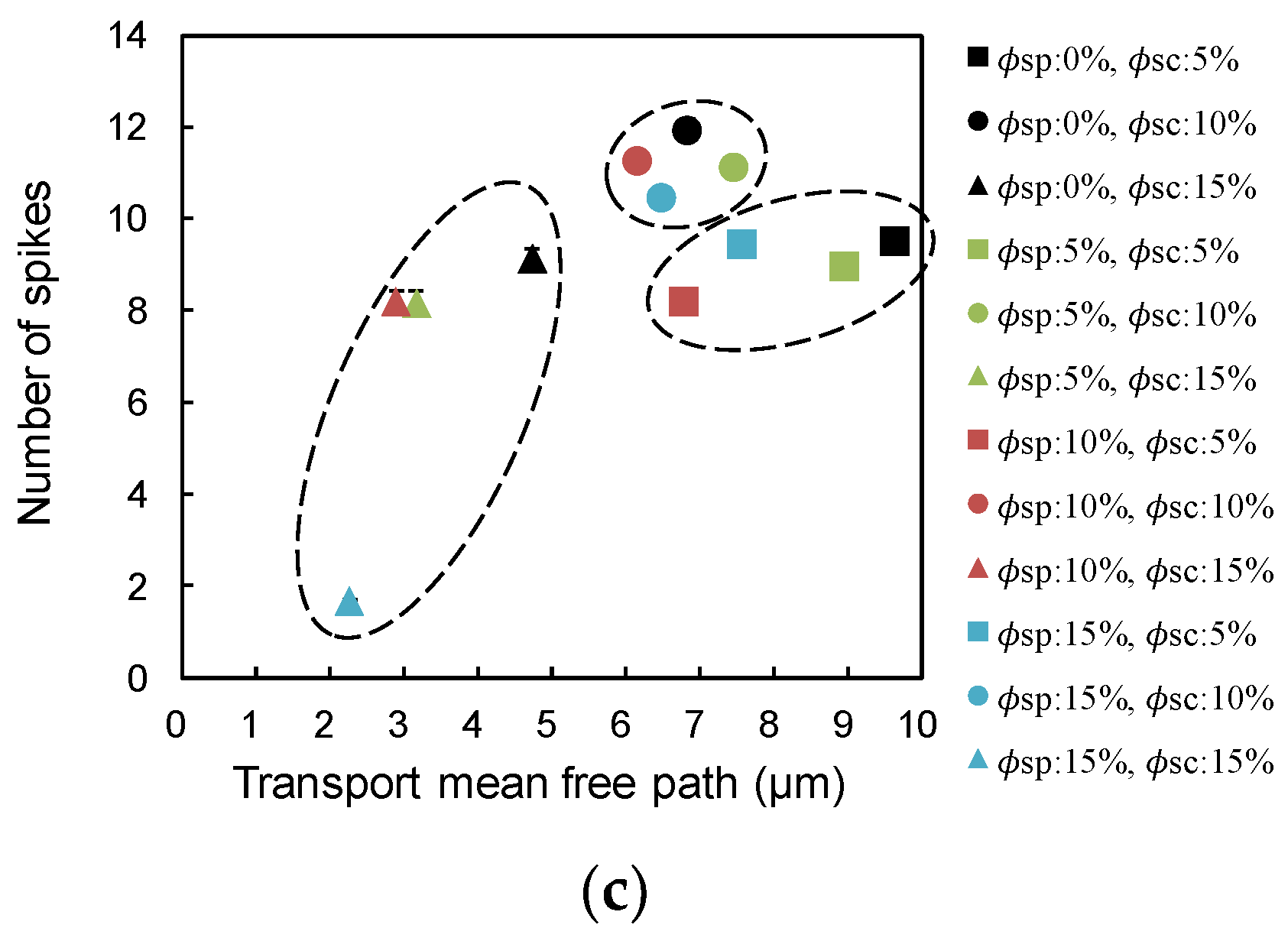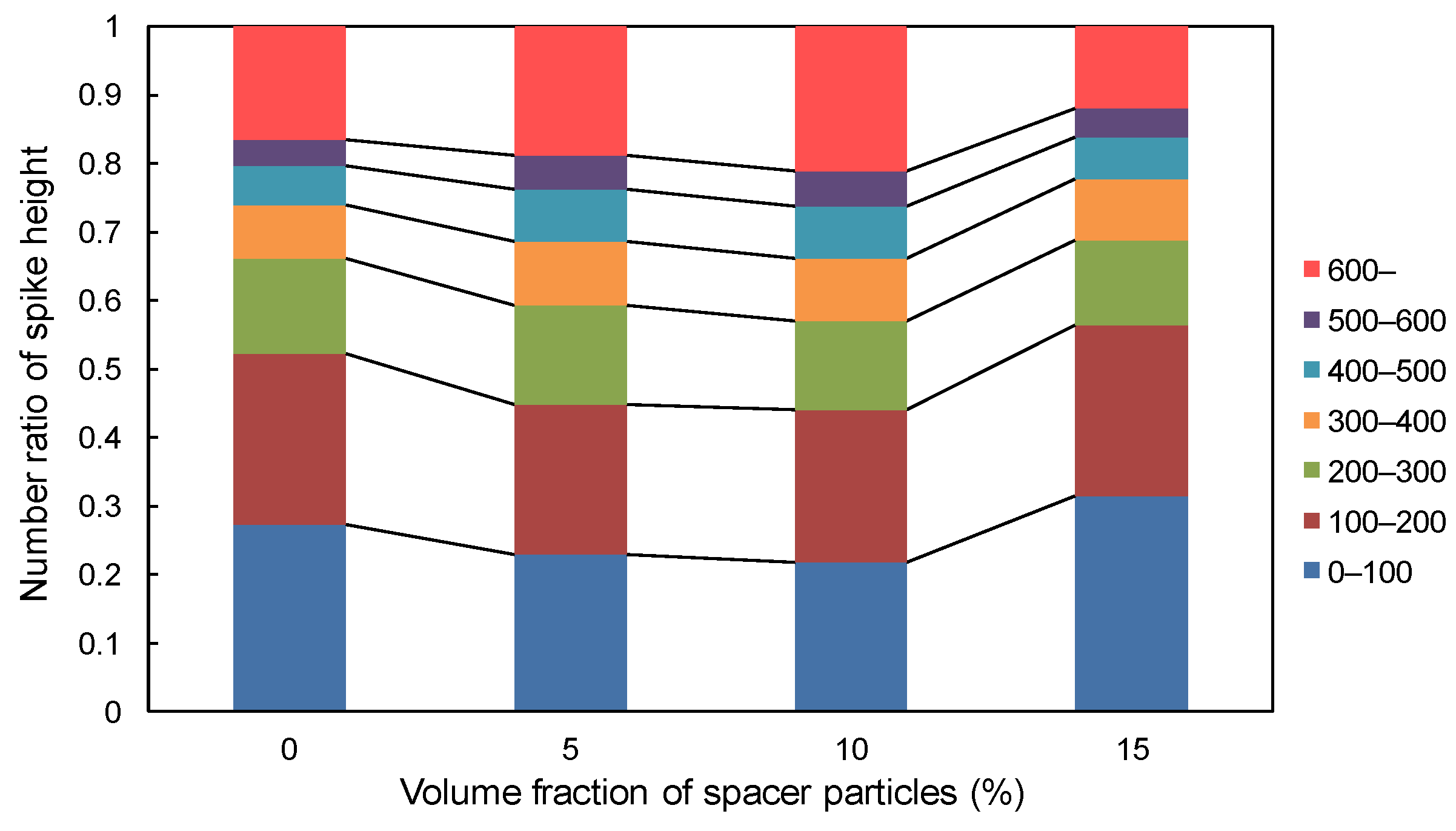Random Laser Action in Dye-Doped Polymer Media with Inhomogeneously Distributed Particles and Gain
Abstract
1. Introduction
2. Experimental
3. Results
3.1. Incoherent Random Lasing
3.2. Coherent Random Lasing
4. Discussion
5. Conclusions
Author Contributions
Funding
Acknowledgments
Conflicts of Interest
References
- Wiersma, D.S. The physics and applications of random lasers. Nat. Phys. 2008, 4, 359–367. [Google Scholar] [CrossRef]
- Cao, H. Review on latest developments in random lasers with coherent feedback. J. Phys. A Math. Gen. 2005, 38, 10497–10535. [Google Scholar] [CrossRef]
- Noginov, M.A. Solid-State Random Lasers; Springer: New York, NY, USA, 2005. [Google Scholar]
- Cao, H. Lasing in disordered media. In Progress in Optics; Wolf, E., Ed.; Elsevier: Amsterdam, The Netherlands, 2003; Volume 45. [Google Scholar]
- Luan, F.; Gu, B.; Gomes, A.S.L.; Yong, K.T.; Wen, S.; Prasad, P.N. Lasing in nanocomposite random media. Nano Today 2015, 10, 168–192. [Google Scholar] [CrossRef]
- Sznitko, L.; Mysliwiec, J.; Miniewicz, A. The role of polymers in random lasing. J. Polym. Sci. B 2015, 53, 951–974. [Google Scholar] [CrossRef]
- Andreasen, J.; Asatryan, A.A.; Botten, L.C.; Byrne, M.A.; Cao, H.; Ge, L.; Labonté, L.; Sebbah, P.; Stone, A.D.; Türeci, H.E.; et al. Modes of random lasers. Adv. Opt. Photonics 2011, 3, 88–127. [Google Scholar] [CrossRef]
- García-Revilla, S.; Fernández, J.; Barredo-Zuriarrain, M.; Carlos, L.D.; Pecoraro, E.; Iparraguirre, I.; Azkargorta, J.; Balda, R. Diffusive random laser modes under a spatiotemporal scope. Opt. Express 2015, 23, 1456–1469. [Google Scholar] [CrossRef] [PubMed]
- Gottardo, S.; Sapienza, R.; García, P.D.; Blanco, A.; Wiersma, D.S.; López, C. Resonance-driven random lasing. Nat. Photonics 2008, 2, 429–432. [Google Scholar] [CrossRef]
- Uppu, R.; Mujumdar, S. Persistent coherent random lasing using resonant scatterers. Opt. Express 2011, 19, 23523–23531. [Google Scholar] [CrossRef] [PubMed][Green Version]
- Gaio, M.; Peruzzo, M.; Sapienza, R. Tuning random lasing in photonic glasses. Opt. Lett. 2015, 40, 1611–1614. [Google Scholar] [CrossRef] [PubMed]
- Fujiwara, H.; Niyuki, R.; Ishikawa, Y.; Koshizaki, N.; Tsuji, T.; Sasaki, K. Low-threshold and quasi-single-mode random laser within a submicrometer-sized ZnO spherical particle film. Appl. Phys. Lett. 2013, 102, 061110. [Google Scholar] [CrossRef]
- Wu, X.H.; Yamilov, A.; Noh, H.; Cao, H.; Seelig, E.W.; Chang, R.P.H. Random lasing in closely packed resonant scatterers. J. Opt. Soc. Am. B 2004, 21, 159–167. [Google Scholar] [CrossRef]
- Okamoto, T.; Adachi, S. Effect of particle size and shape on nonresonant random laser action of dye-doped polymer random media. Opt. Rev. 2010, 17, 300–304. [Google Scholar] [CrossRef]
- Wetter, N.U.; Giehl, J.M.; Butzbach, F.; Anacleto, D.; Jiménez-Villar, E. Polydispersed powders (Nd3+:YVO₄) for ultra efficient random lasers. Part. Part. Syst. Charact. 2018, 35, 1700335. [Google Scholar] [CrossRef]
- Sciuti, L.F.; Gonçalves, T.S.; Tomazio, N.B.; de Camargo, A.S.S.; Mendonça, C.R.; De Boni, L. Random laser action in dye-doped xerogel with inhomogeneous TiO2 nanoparticles distribution. J. Mater. Sci. Mater. Electron. 2019. [Google Scholar] [CrossRef]
- Leonetti, M.; Lopez, C. Random lasing in structures with multi-scale transport properties. Appl. Phys. Lett. 2012, 101, 251120. [Google Scholar] [CrossRef]
- Okamoto, T.; Yoshitome, R. Random lasing in dye-doped polymer random media with a bubble structure. J. Opt. Soc. Am. B 2017, 34, 1497–1502. [Google Scholar] [CrossRef]
- Akkermans, E.; Wolf, P.E.; Maynard, R. Coherent backscattering of light by disordered media: Analysis of the peak line shape. Phys. Rev. Lett. 1986, 56, 1471–1474. [Google Scholar] [CrossRef] [PubMed]
- Barthelemy, P.; Bertolotti, J.; Wiersma, D.S. A Lévy flight for light. Nature 2008, 453, 495–498. [Google Scholar] [CrossRef] [PubMed]
- Lee, M.; Callard, S.; Seassal, C.; Jeon, H. Taming of random lasers. Nat. Photonics 2019, 13, 445–448. [Google Scholar] [CrossRef]









© 2019 by the authors. Licensee MDPI, Basel, Switzerland. This article is an open access article distributed under the terms and conditions of the Creative Commons Attribution (CC BY) license (http://creativecommons.org/licenses/by/4.0/).
Share and Cite
Okamoto, T.; Mori, M. Random Laser Action in Dye-Doped Polymer Media with Inhomogeneously Distributed Particles and Gain. Appl. Sci. 2019, 9, 3499. https://doi.org/10.3390/app9173499
Okamoto T, Mori M. Random Laser Action in Dye-Doped Polymer Media with Inhomogeneously Distributed Particles and Gain. Applied Sciences. 2019; 9(17):3499. https://doi.org/10.3390/app9173499
Chicago/Turabian StyleOkamoto, Takashi, and Masaki Mori. 2019. "Random Laser Action in Dye-Doped Polymer Media with Inhomogeneously Distributed Particles and Gain" Applied Sciences 9, no. 17: 3499. https://doi.org/10.3390/app9173499
APA StyleOkamoto, T., & Mori, M. (2019). Random Laser Action in Dye-Doped Polymer Media with Inhomogeneously Distributed Particles and Gain. Applied Sciences, 9(17), 3499. https://doi.org/10.3390/app9173499




